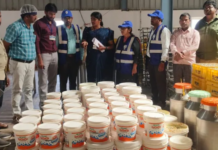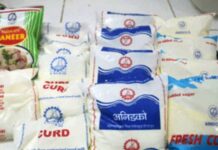New Delhi, March 03, 2021: Today, butter in India is synonymous with a blue-haired ‘utterly butterly’ girl dressed in red and white polka dots, holding the telling yellow slab of salty butter in her hand. Amul needs no further introduction. Millions of Indians are a testament to how easily a brand can become such an integral part of an entire country’s life.
But much before Anand Milk Union Limited (Amul), there was another brand of butter whose taste carries on to this date, some 70 years down the line.
As Alka and Rakesh Singh, residents of Delhi recall, this butter was “creamier” and was a prominent part of many Indian households, much before Amul came into the picture. Alka (64) was only around six years old when Polson was all the rage, and recalls how, even while making a transition to Amul, her family held the former close to their heart.
Kalpana Vatsa (74), another Delhi resident, recalls her days in Khurja city in Uttar Pradesh, and particularly her travel back and forth between UP and Nainital, where she was studying at the time. “Buying ration from railway stations was a fairly common thing back then,” she says. “I remember I used to buy Polson in bulk to take back with me. The packets were massive, not like the 100 gram slabs of Amul we buy today.”
Fueled by the British
Butter gained popularity here when the British arrived. Food scientist and historian K T Achaya noted one of the first references to the food item sometime around 1780, when Mrs Eliza Fay in Calcutta used generous servings of it in her afternoon meal. Butter was more or less being made domestically at the time, possibly by using malai left atop milk. Largescale manufacturing, however, came through a young Parsi boy.
Before Polson became a household name, it was a coffee manufacturing unit in erstwhile Bombay. Pestonji Edulji Dalal opened a small store in 1888, at the age of 13, to roast and grind coffee. As Ruth Heredia chronicles in The Amul India Story, Edulji began his venture with a sum of Rs 100 he had borrowed from his sister, and set up the store at a rent of Rs 8 per month. The coffee was ground with a single hand-operated machine, and fresh powder was packed in brown paper bags and sold door-to-door. The name of the store came about because Edulji was affectionately known as Polly, and to bring into effect a British-sounding name, decided to name his brand Polson. His patrons were mostly white sahibs and the upper class. As business grew, Edulji expanded shop in 1905 and 1907, and began selling a chicory blend he called Polson’s French Coffee, and described it as “blended according to French recipe”.
The British were regular customers of this young prodigy’s store, and by 1910, Edulji’s brand had become well-established. In search of new opportunities at the time, he came across a customer of the Supply Corps, who told him there was a lack of butter supply for the armed forces. Edulji jumped in to help, and set up a dairy in Kaira (Kheda) in Gujarat, and networked through railway and army officials to scale the production of butter according to the reports published in thebetterindia.com.
‘Polson laga na’
Heredia says Polson’s success was built on the foundation of three wars — The Boer War, and the two World Wars, where Edulji supplied butter to British Indian and American forces. By 1930, Polson’s modern, well-equipped, and highly automated dairy was set up in Anand. “Soon, wherever there was a marketing outlet, Polson’s Butter joined Polson’s Coffee at the top of every upper class housewife’s grocery list,” noted Heredia. Civilians were drawn in with alluring marketing strategies such as gift coupons, which were sold with every slab of butter and could be collected to later exchange for mixers and toasters. By 1945, Polson Butter had hit a record production of 3 million pounds every year. Polson’s synonymy with butter was like that of ‘Xerox’ and photocopy — the brand name defined the product. In Kashmir, as per this account, flattering (or buttering) was often called ‘Polsoning’.
By 1946, Amul had arrived into the picture. Polson had been enjoying uninterrupted monopoly with government support, and farmers were unable to sell their milk to other vendors in the market. In 1945, the Bombay Government had started the Bombay Milk Scheme, which involved bringing milk from Kaira, covering a distance of around 400 km, to the city and selling it at subsidised prices. This monopoly had been awarded to Polson. The benefits of the costly price paid by the scheme was not being passed to the producers, and farmers of Kaira essentially were no better off than before. As discontent grew, a delegation met Sardar Vallabhai Patel, and on his advice, launched the dairy cooperative that eventually paved way for Amul.
The result was that it failed to gain notoriety because Polson’s distinct taste had a loyal fanbase, who found Amul’s version lacklustre and flavourless. The former salted their butter heavily, which also gave it a much longer shelf life. Of course, as we know now, eventually Varghese Kurien had caught up. Amul began salting its butter and adding the yellow colour that signified the cow’s milk that most Indians were comfortable with, as opposed to white buffalo milk.
A quiet comeback
In the 60s, Sylvester De Cunha and Eugene Fernandez came on board to design the Amul girl in response to Polson’s butter girl. The latter was depicted as a blonde haired girl dressed in a blue and white striped dress, surrounded by cans of Polson’s, buttering a toast. The butter was being marketed as something that was loved by children, and parents were advised to “guard their health and offer them the best”. Polson’s girl was a softer, more sophisticated mascot, while Amul’s was somewhat of a firebrand, who had the perfect puns for any given trend in the country at the time.
As Amul’s marketing strategy gained a stronger foothold, and once it had perfected the taste that Indians so desired, Polson’s existence in the market dwindled. Edulji’s monopolistic practices ultimately led to his company’s downfall, and as we know now, Amul steadily replaced Polson with fairer and better practices, and catapulted the white revolution in the country. By the ’70s, Edulji’s children had moved away and with no one left to carry the business forward, the company was bought over and then diverted towards tanning and leather products.
In 2012-13, there was a slow rumble among Polson fans that the butter was reportedly making a comeback. One shop was, in fact, found selling the item. It was an establishment known as Farm Products in Colaba, Mumbai. The store is over a century-old, and is the city’s oldest cold storage. The brand was reportedly re-launched by Edulji’s relative, but the rest of the family was not too happy with the decision. The brand vanished once again, and has not resurfaced since.
Other companies have since tried to gain a stronger foothold in the butter market but what fails to resonate with most Indians is the uniquely salty taste. Amul finds itself precariously placed having found the perfect balance that caters to both Indian and foreign tongues. The taste may still be vaguely familiar with its older client base. One could argue that it is, in fact, a hint of Polson’s taste that lingers to this day.



































